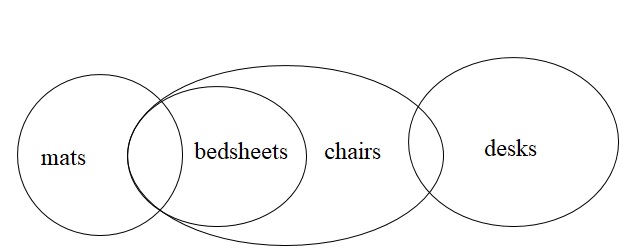Question
Statements: Some mats are bedsheets. All
bedsheets are chairs. Some chairs are desks. Conclusions: I. Some desks are bedsheets. II. Some chairs are mats. III. Some mats are desks. In each question below are given three statements followed by three conclusions numbered I, II and III. You have to take the two given statements to be true even if they seem to be at variance with commonly known facts and then decide which of the given conclusions logically follows from the two given statements, disregarding commonly known facts.Solution
A + I = No conclusion. Hence, conclusion I and III will not follow. Some mats are bedsheets (I) + All bedsheets are chairs (A) = Some mats are chairs (I) ⇒ conversion ⇒ Some chairs are mats (I). Hence, conclusion II will follow. Alternate method:  Conclusion I: Not necessarily true based on given venn diagram. Conclusion II: It is true based on given venn diagram. Conclusion III: Not necessarily true based on given venn diagram.
Conclusion I: Not necessarily true based on given venn diagram. Conclusion II: It is true based on given venn diagram. Conclusion III: Not necessarily true based on given venn diagram.
Labour cost that is specifically incurred for or can be readily charged to or identified with a specific job, contract, work order or any other unit of ...
What is the term for the ethical principle that involves keeping promises and being truthful?
In July 2024, which economic indicator was recorded as the lowest in the last 59 months?
The Unified Pension Scheme (UPS) has been based on the recommendations of which of the following committee?
What is one disadvantage of the systems approach?
Saurabh is a project manager on an industrial design project. He set up a reward system, but he was surprised to find out that the team is actually less...
Who has been appointed as the new Managing Director (MD) and Chief Executive Officer (CEO) of Paytm Payments Bank?
Which of the following is NOT a difference between a commercial bank and a cooperative bank?

